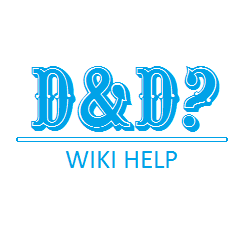Help:Browsing
Browsing D&D wiki
Locating particular items or types of articles may seem daunting to the new user, but once you come to understand the method to the madness you'll be able to locate items quickly and easily.
The D&D wiki navigation uses a pinpoint method. You'll start by finding the general type or classification of the item you're looking for. Then, you'll slowly narrow down types and classifications until you locate the particular articles you're seeking. For example, if you are trying to find user-created variant feats for the Barbarian rage ability, you would start from the Main Page by clicking on 3.5e Homebrew. On this page, you'll look for the link that best describes what you want - which in this case is 3.5e Character Options which will quickly link you to 3.5e Feats. A quick scan of this page and you'll see 3.5e Rage Feats, and then you have found all of the user-created rage feats.
If at any point you believe you've clicked something wrong and want to go back, you can utilize the Back To feature of your browser or scroll to the bottom of the page to find the breadcrumb. Breadcrumbs are lines of text at the end of articles that can be defined as "Back To Footers." On the main navigation pages (as in the example given above), this breadcrumb is actually at the top of the page.
Categories
If you have located an article you enjoy, and would like to see similar articles, you may wish to check out the categories of the article. Categories help define and group similar article content together. For example, lets say you are looking at the Infamy (3.5e Variant Rule) page and enjoy that supplemental game mechanic. Locate the categories at the bottom of the page. Some of those categories are very generalized and broad, such as DnD, User, and the edition specific categories. As such, these may not really narrow the results down to the most similar articles. However, by clicking on the Category:Valgora Other category you'll quickly find the very similar Karma (3.5e Other) page.
Search
The search function is the most obvious of your choices when looking for particular articles. However, the search function does not actually operate like the ones found on some sites. A more accurate description may be "quick link." If you type in the exact name of a page (including identifiers), it will direct you immediately to that page. If nothing shows up, don't despair. A page will allow you to do a more traditional search by clicking again.
Article Titles
You can tell whether an article is 'official', OGC, or homebrew content, by the article title alone. If the name begins with "SRD:", "5e SRD:", "3e SRD:", etc. These are the official documents released by WotC under OGL licensing. Other articles beginning with "OGC:" are Open Game Content, released from third party publishers under OGL licensing (you should check with your DM before using these). If an articles ends with a page ID, such as "(3.5e Class)", or "(5e Equipment)", it is a homebrew article made by one or more of our users, (you should definitely check with your DM before using these, as they may be unbalanced or incomplete.).
